The Complete Guide to Kick-Off Your Career as a Product Manager
The go-to guide for you to start your career in Product Management

I've received several questions on how someone could start their career as a Product Manager.
Before I begin my guide, I should point out that there is no clear-cut definition of what Product Manager do in a daily basis. There are some guides / learning materials out there that might give you some ideas on how to start your career as a Product Manager, but it really comes down on how each company / institution of what your job is.
This will be one of those TL;DR articles, so you can jump into the points that you want to read immediately, but if you want the full experience and you're just starting out, I recommend you to read all of these guides as it will be updated every now and then.
Who is Product Manager?
Let's start with the elephant in the room - asking who product manager is, what they do on their daily basis, and what is their actual job.
If you have the time to search it on google, you will find many definitions but the majority of the result will be: A Product Manager is a person that is responsible in defining, developing, and iterating a product in a continuous cycle.

What that means is, a Product Manager is a person whose main job is to ensure everything that has to do with their product runs smoothly and effectively. They have to make sure that every decision that they make is making a difference (in a good way) for customers and company.
Product Manager has to be the most self-less person in the world. They have to receive the blame if something is wrong with their product and at the same time, they have to give the credit to other poeple when the product is succesful, I will tell the reason why at the other part of this article.
Furthermore, Product Manager is someone that have a functional role in a company. It means that Product Manager does not have a "team" per se within a company since the team that they are interacting with actually belongs to other departments. The closest example being: The Engineering Team.
On a daily basis, Product Manager will work with Engineering Team to discuss technicalities regarding an issues or solutions and in some occassions, lead them. But it doesn't make Product Manager the supervisor of Engineering Team, the Engineering Team would have their respective supervisor.
The Skills of Product Managers
I have referred this topic on one of my articles, but let me re-iterate it here. Additionally, I have done a research on what kind of skills and education background most Product Manager has in Indonesia. Here's the findings:
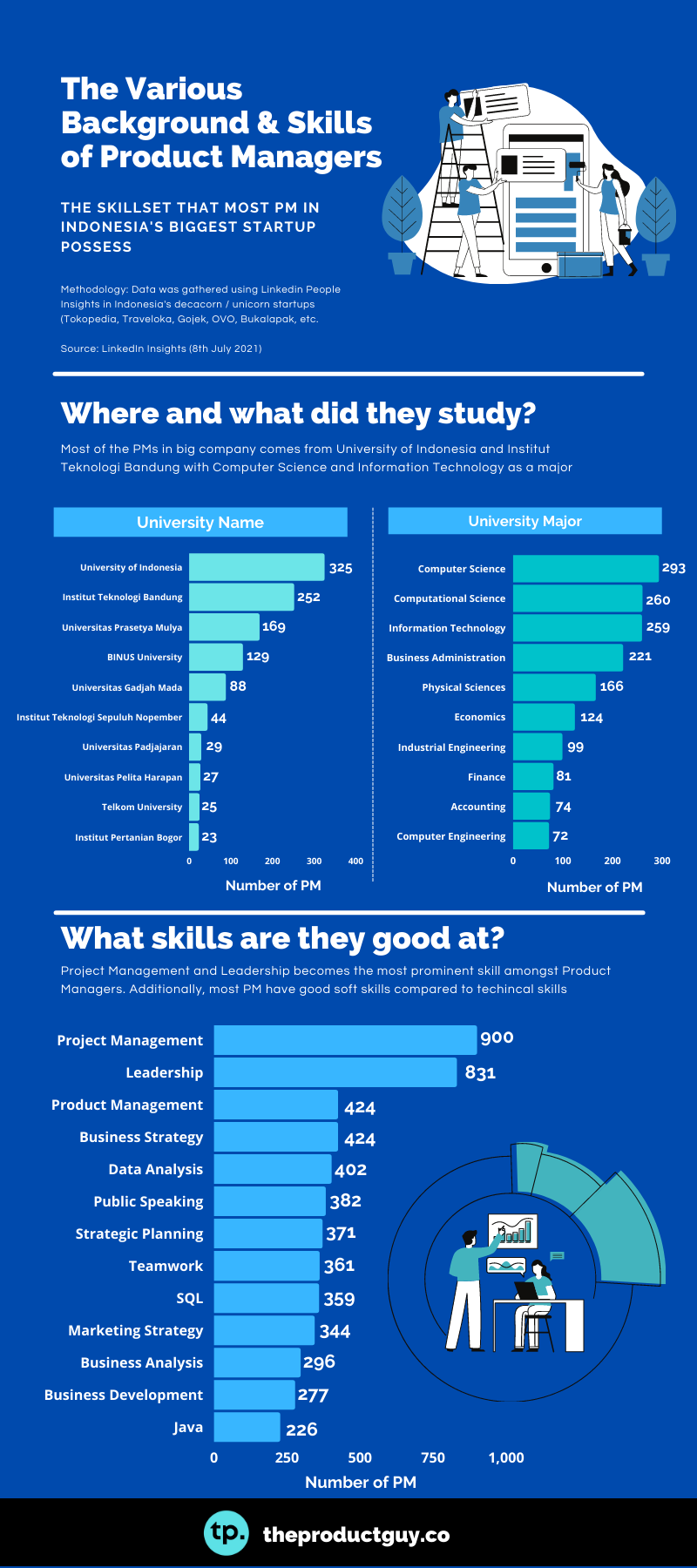
The research that I did sometime ago shows that Product Managers are not acknowledged for their technical skills even though most of them came from a more technical educational background. Most of them are highly skilled in several soft skills such as leadership, strategy, public speaking, planning, and teamwork. With that being said, when you want to start your career as a Product Manager, it is advisable for you to sharpen these skills:
1. Leadership
There are several ways to improve your leadership skills:
- Build and mentor the right team
A leader is only as good as their team. Instilling ownership within your team is a must in order to become a great Product Manager. Good leaders focus on their team’s growth and become set an example for their team. On top of that, good leaders inspire their team to become better than the leader himself so they may lead in the future.
- Develop processes and practices that improve team work
As a leader, it is your job to improve every aspect of your team. Additionally, you have to able to come up with new innovations and procedures to make your team work more effectively
- Create a culture of collaboration
For some companies, product development is at the heart of the business. Being a Product Manager means that you have to work with several cross-functional teams. You have to understand what they need and what you can do to solve their problems. The only way to do that is by communicating and talking to them.
- Promote a customer-centric culture
When you develop a product, take account of the people that use it. As well designed as a product is, it won’t succeed if it does not mean anything for the user.
- Consistently experiment and learn
Product teams have a great deal of influence over whether a business succeeds or not. In today’s fast-paced business landscape, successful product teams make experiment-driven learning a high priority.
2. Strategic Thinking
Product Manager is a strategic role that ensures the state of the product in the future. Making a strategic decision can be hard if you do not know the right way to do it. These are several tips that you can use to sharpen your strategic thinking skills:
- Research – Make sure the decisions are well-informed with thorough research into a variety of factors that may influence the decision
- Measure – Choose objectives and accompanying metrics that are most suited to determine the success of strategic solution
- Prioritize – Arrange possible solutions or problems that can be implemented first
- Consensus – Involving others to see whether a strategic decision impacts others in a positive way
3. Empathy
Being a Product Manager means that you have to understand what your user needs and able to solve their problem. Empathy is a must-have skill for any Product Manager to understand their users. There are several ways to improve your empathy:
- Listen
Get out of the building. Reach out and get into conversations with others. You should be observing and listening to users on at least a weekly basis (ideally, multiple times a week).
- Turn insights into action
The best insights mean nothing if you don’t a). remember them or b). share them with others.
- Shorten feedback loops
When you have forward progress, go back and quickly validate with additional conversations. After a feature launches, go watch someone use it. Don’t assume you know about every change in the market — reach out and talk to people. If your processes lack opportunities for feedback, you lose the potential for empathy.
The Product Management Team
As I've mentioned earlier, Product Manager is a functional role, they will lead a cross-functional team across different deparments. Their job is to lead and give directions so each of those team will have a common goal.
With that in mind, we need to know who Product Managers be working with. That said, each company might differ but this diagram below should give a solid explanation.
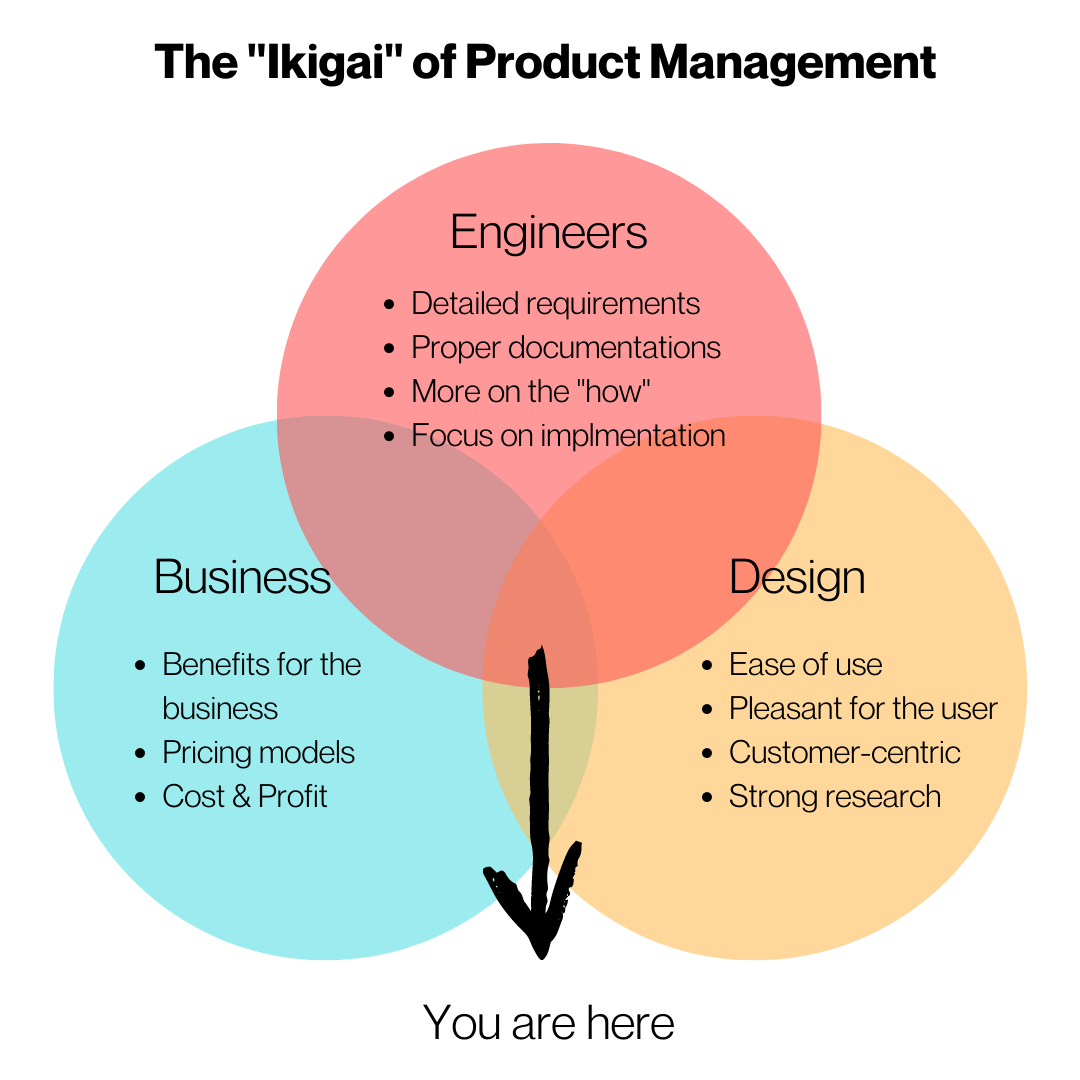
Based on that diagram, you know now what the Product Management Team consists of:
- Engineering Team (Technical)
- Business Team (Financial)
- Design Team (Visual)
Each of the team have their own unique trait, so it's not rare that many source called Product Manager: Jack of all trades, master of none. Throughout your career as a Product Manager, you will have at least work with either 2 if not all of the mentioned team.
The Engineering Team will advise you regarding the best practices on the technical side. Additionally, they will help you to assess the ease of implementation and whether something can be implemented or not. That said, it doesn't require you to fully understand code, what you need to understand is the impact that it will bring to your product.
Secondly, there is the designer team. Before handing the job over to the engineering team, you have to brief your designer team regarding what kind of features or enhancements that you want to make. Similarly with the engineering team, you have to give a clear direction to them to ensure the output is the same with the initial requirement
Moving on to the business team, they are the ones who will help you to determine the price on your product. Additionally, they can act as a voice of the customer as well since they are one of the teams that have a lot of touchpoints with the customers so their feedback is very important.
Bear in mind, that the number of teams that interacted with the Product Management team may vary in each company but those 3 teams are the main touchpoints that any Product Manager will have in any company. So, it's important for Product Managers to have a good relations with them.
The Product Manager Mindset
Finding customer's problem is one of the key differentiation between an "okay" Product Manager and the great Product Manager. You will need to be curious and at the same time be a good listener. Moreover, you need to prioritze your customers.
Your customer have to be the center of your work, they are the ones that interacts with your product - making them your most valuable assets. Not listening to your customers is the last thing that you want to do.
Being a good listener, can help you to find the real root cause of the problem. Here are some ways to become a good listener:
Do active listening
There's a thin line between listening and active listening. Active listening means that you are constantly observing for any behavioral or physical cues that indicates sudden change of emotions such as hand gestures, speaking tone, twitches, an many more.
At the end of every active listening, the listener should give a feedback in a form of accurate paraphrasing. Indicating that they have fully understand what their partner were saying.
Ask for clarification
Communications has always been a two way street. You have to understand each other to reach common ground. That said, it is easier said than done. One single word could have different perception between two different person.
With that in mind, you have to ask for clarification at then of every conversation with your customer. You can start by asking these type of questions:
- When you mean by X, do you mean it's Y?
- So just to reconfirm, you are currently do X and Y?
- So what you were saying that X is better than Y because of Z?
Asking for constant clarification at the end of a question could help you to get a better undstanding of what the customer really meant.
Be open minded
As it obvious as it seems, this will be the hardest thing that you will do. Once an idea is planted inside someone's mind, it will be very hard to change it - being a Product Manager is no exception.
When you've finished creating your product / feature, you will have a sense of pride that sometimes hinders you to listen for outside feedback. You have carefully plan the products and you think everything is perfect and went down according to plan.
Suddenly, you were presented by the hard truth that your customer don't understand how to use the product. Being an open minded person means that you can receive feedback (even brutal ones) with open arms.
One thing to remember is: the most valueable feedback will come from the unhappiest customers.
How to Map The Customers' Problem
Once you know how to do proper listening, it's time for you to learn on what kind of interviews that you can do with your customers. There are several types of interviews depending on which stage that your product are in right now:
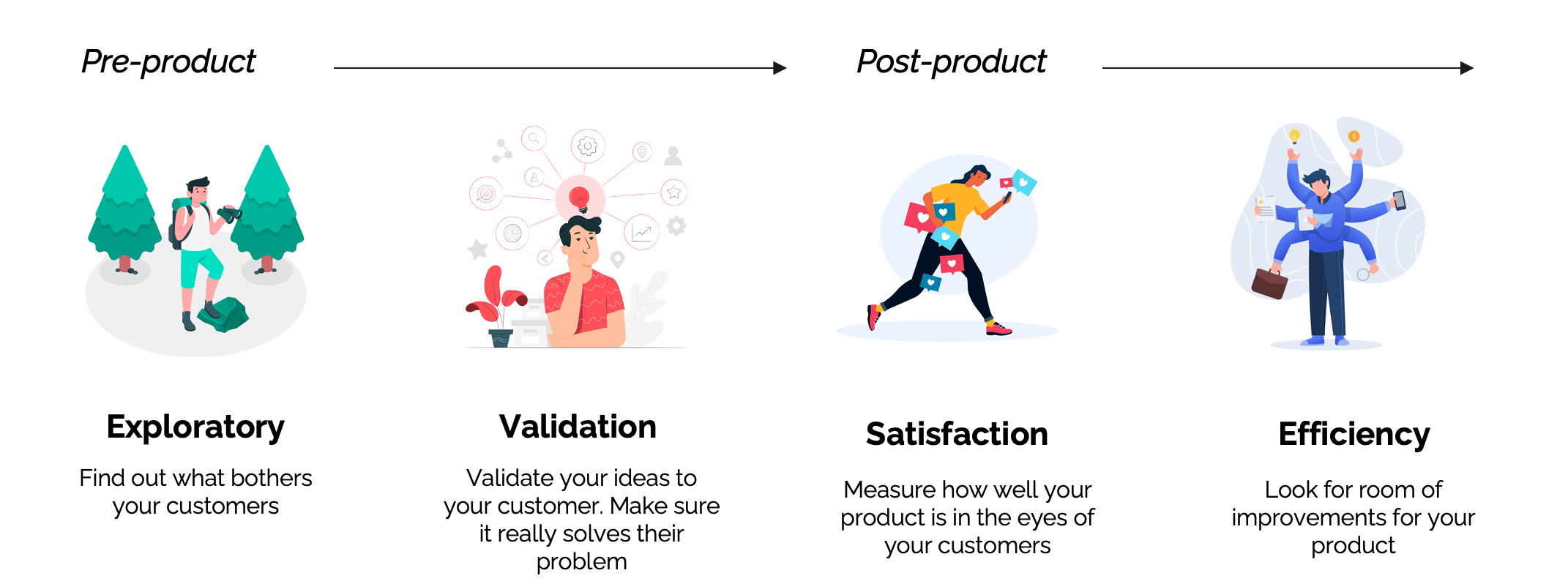
- Exploratory Interviews: This type of interviews begins at the very early stage before your product is created. The type of questions is as follows: When you want to do x, what do you need? What do you feel when you are unable to do x? When I talk about x, what kind of thing that came out of your mind?
- Validation Interviews: You can do this interview when you want to validate your solution or problem to your customers. You can begin by asking: Is this what you need? Does doing x poses a problem for you? Does x makes you feel happy / sad?
- Satisfaction Interviews: When your product has finally entered the market, you will need to measure whether it actually solve people's problem. You can ask simple questions such as: What makes you happy when you use this product? Will you continue using the product? If this product does not exist anymore, will you be dissapointed?
- Efficiency Interviews: At the later stage of your product, you will need to see whether the product that you made served it purpose. You need to see how much time / money that the customer save by using your product.
After you find the problems, you will need to prioritize them. Finding the right problem that needs to be solved first. One of the easiest framework that you can use is the Eisenhower Framework
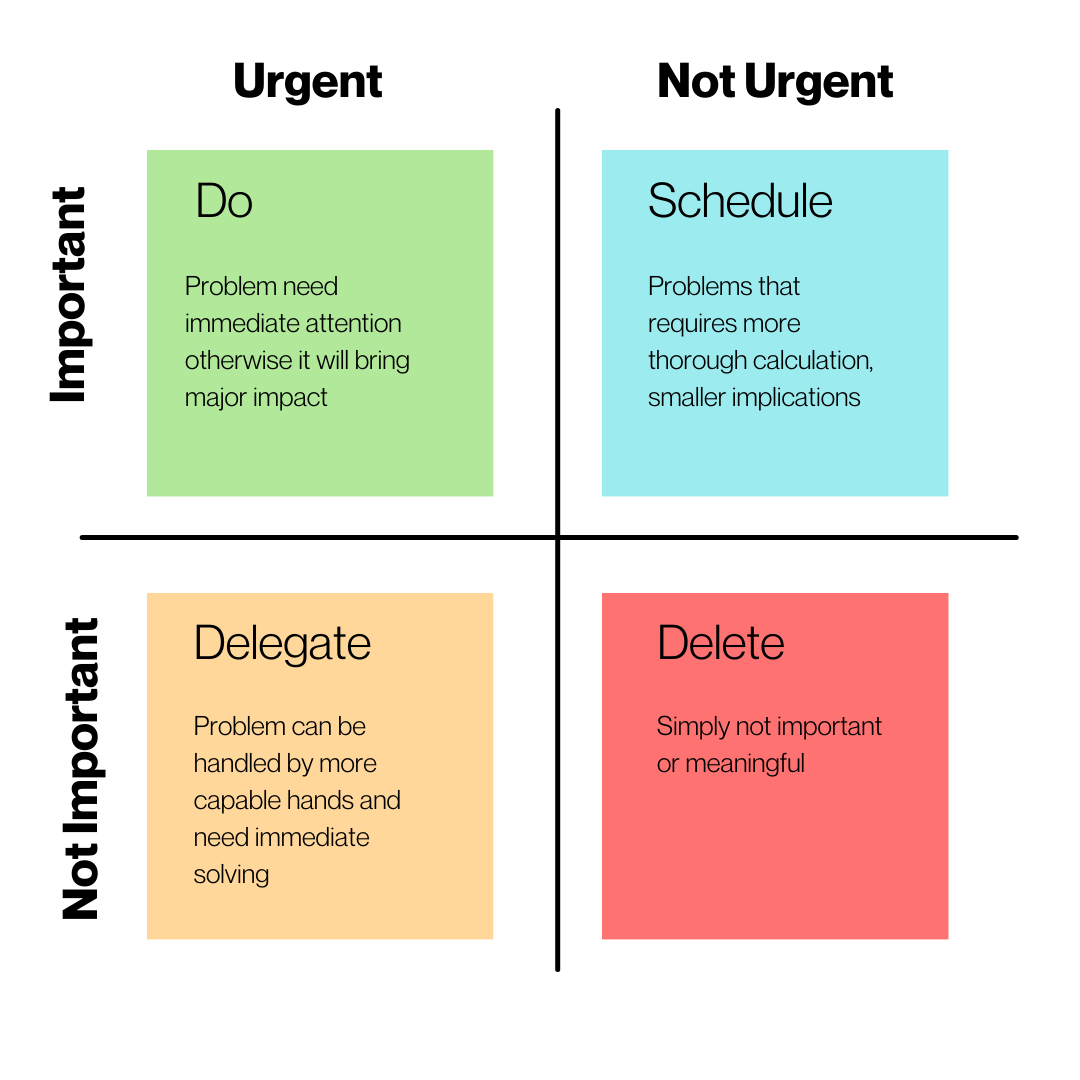
Eisenhower Framework consists of four quadrants:
- Do (Important & Urgent): This is the most important and urgent problems that needs to be solved. Leaving this problem unattended could have devastating effects for your product in the long run
- Schedule (Important & Not Urgent): This is the major problems that the customers are facing, but it's more forgiving since this issue only bring a relatively smaller impact.
- Delegate (Not Important & Urgent): These are the type of problems that needs to be solved immediately, but you can delegate it to a more capable hand, ie. bugs & error can cause customers' dissatisfaction but it can be solved by the engineers
- Delete (Not Important & Not Urgent): Simply forget about this problem.
How to Prioritize Your Solutions
With the handful of problems that the Product Managers have to solve and the limited resource and time that they have, solution prioritization framework is a must-have skill for any Product Manager to start their career.
There are several frameworks that you can use to prioritize solutions. Here are some of the most notable one:
R.I.C.E. Framework
R.I.C.E. or RICE stands for Reach, Impact, Confidence, and Effort. These components then measured using the simple calculation shown below:

Reach can be calculated by the estimation of how many users that will be impacted / use the feature. For instance, if you have 10,000 users than around 30% of the total users will use this feature, then the reach becomes 3,000
Impact is the measurement of how big the feature will change the customer's behavior or bring benefits to the company. Impact is measured using this scale:
- 3 = massive impact
- 2 = big impact
- 1 = medium impact
- 0.5 = small impact
The next one is Confidence which can be measured from the estimation of:
- How confident are you with the given timeline?
- How confident are you to complete the project / product with the current technology?
- How confident are you with the current team's capabilities?
Confidence can be measured by using a percentage scale:
- 100% = high confidence
- 80% = medium confidence
- 50% = low confidence
The last one is Effort. This component is measured by how big is the scope of the work. You can measure Effort based on:
- How long do you need to finish the project?
- How many people that you need to finish the project?
- How much money that you need to spend to finish the project?
You can use the 1 - 6 scale to calculate effort. 1 being the best since it means you only require not as much effort.
Kano Model
The Kano Model is a method to prioritize based on how likely the feature will satisfy the customers. Product Managers often used Kano Model to group categories of solutions and it helps the team to find which feature is the one that is absolutely necessary for the customers and which ones aren't.
The Kano Model mainly categorize two types of feature:
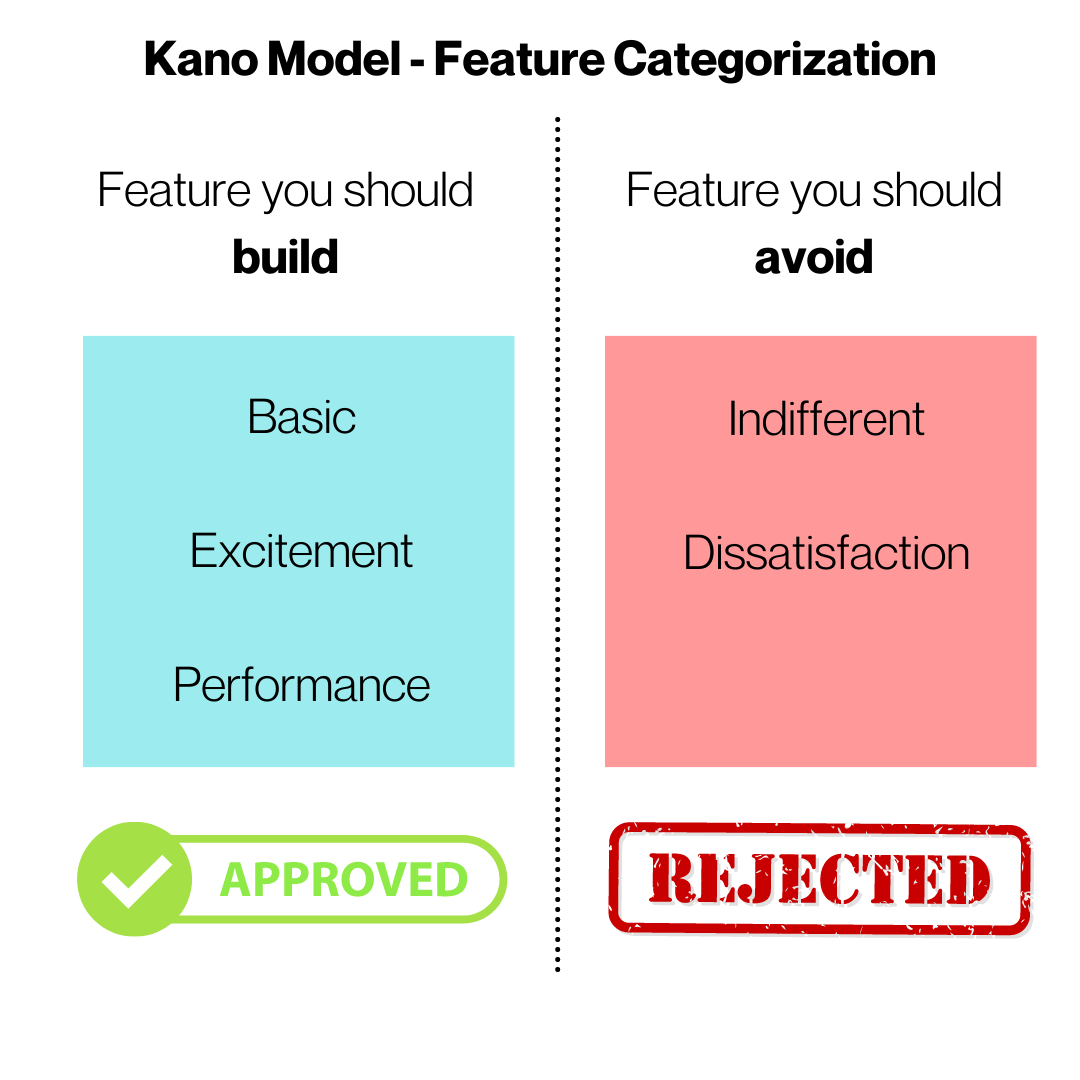
To determine which feature is which, you can ask this to your customers:
- What do you feel if the product have this feature?
- What do you feel if the product don't have this feature?
Then for each of those questions, the customers will need to answer one of these options:
- I like it
- I expected it
- I don't care
- It makes no difference
- I don't like it
Last but not least, there are several conditions that makes Kano Model the right prioritization framework:
- When you have limited time
- When you have limited resources
- When you don't have a lot of features
- When you want to determine the key differentiation of your product
- To create performance enhancing feature
